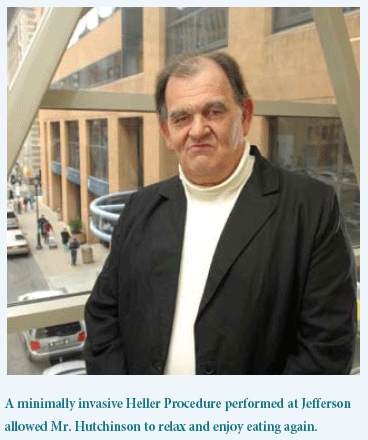
Recommended Citation
(2008)
"Minimally Invasive Procedures Offer Reduced Pain & Shorter Recovery,"
Jefferson Surgical Solutions: Vol. 3:
Iss.
1, Article 1.
Available at:
https://jdc.jefferson.edu/jss/vol3/iss1/1
Included in
Each of Jefferson’s three fellowship-trained minimally invasive surgeons are busy performing anywhere from four to eight such operations every week. These include procedures done endoscopically (guided by an endoscope usually inserted through the mouth) and laparoscopically (performed via instruments inserted through small incisions).

"These procedures really push the envelope," says Assistant Professor Francis Rosato, Jr, MD (JMC Class of ’99). "They shorten recovery time, decrease pain, and have very good cosmetic results, so patients can resume normal activity much faster."
"With peri-esophageal procedures especially," says Assistant Professor Bernadette Profeta, MD (JMC Class of ’97), "there’s a significant difference in terms of recovery. Even patients in their 80s can be up and around within 3 days."
These procedures... shorten recovery time, decrease pain, and have very good cosmetic results, so patients can resume normal activity much faster.
According to Assistant Professor Karen Chojnacki, MD, a laparoscopic approach is particularly useful for a condition called achalasia. In this disease, the valve at the bottom of the esophagus fails to relax and open when the patient swallows. The patient experiences this as food getting stuck in his or her chest, and the only option is regurgitation of the undigested food. "This can become so pervasive that the individual won’t eat in public and sometimes stops eating altogether," she says.
Harry Hutchinson was diagnosed with achalasia in 2002, in his early fifties. At first he noticed difficulty with solid food and then, over time, even swallowing liquids became problematic. Initially he found relief from an injection of botox into the lower esophageal sphincter, which paralyzes the muscle in an open position so that food can enter the stomach. When the symptoms recurred in late 2006, he began to lose weight rapidly. "I dropped 30 pounds in three weeks," Mr. Hutchinson recalls.
Mr. Hutchinson's doctors felt that his best option was a laparoscopic Heller myotomy, a minimally invasive procedure that brought him almost immediate relief (see Surgeon Speaks, at right). "I do a lot of cooking and part of the joy of that, for me, is tasting the food as I go. This procedure has brought back ease and relaxation about such an important part of my life."
Jefferson is looking ahead to performing more advanced laparoscopic procedures, "for GI conditions such as solid organ disease and hernias, as well as endoluminal therapies," says Dr. Rosato. The department is also interested in progressive research including robotics and incision-less procedures done entirely through a tube inserted into the stomach.
"Even since I was a fellow, the equipment for these techniques has developed significantly," Dr. Profeta says, "and now includes high-definition technology that permits even more accurate visualization." This summer Jefferson will launch its own fellowship in minimally invasive surgery, thanks to a grant from Ethicon Endo-Surgery, Inc. The new fellow will begin in July.
The Surgeon Speaks
Achalasia is a disease of the musculature of the esophagus. The cause is unknown. A patient with achalasia cannot swallow food normally because the esophagus no longer contracts to push food into the stomach and the lower esophageal sphincter fails to relax and open when the patient swallows.
A laparoscopic Heller myotomy, which I performed on Mr. Hutchinson, is often the best option for long-term relief. We use long instruments inserted into the abdomen through five small incisions to cut the muscles of the lower esophagus and upper stomach. We also loosely wrap the stomach around the lowest portion of the esophagus to prevent reflux. Surgery takes 45 to 90 minutes. This is the most rewarding procedure I do, because most patients notice an immediate difference—even in the recovery room, they notice they can swallow saliva much more easily. Patients stay in the hospital one to two nights, and generally return to work within one to two weeks. This procedure provides 90 to 95 percent of patients with long-term relief of their symptoms.
Karen Chojnacki, MD
Assistant Professor

